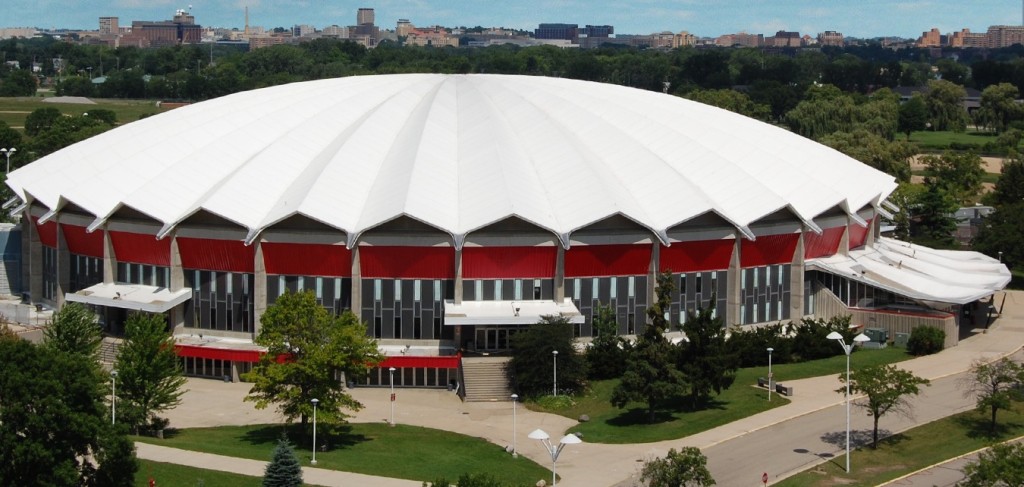One of the coolest things about the 1950s and 1960s was the emergence of Space Age design that made its way into every corner of the culture. Looking back fifty years or so, we can see that futuristic vision had a big impact in arena design in the 1960s and 1970s—and some of those great buildings still stand.
Before the mid-1960s, arena design was by and large a utilitarian endeavor: for every shrine to sports (think Maple Leaf Gardens) you had buildings that didn’t strive for much in the way of a distinctive design, like the third Madison Square Garden. That building, at 50th Street and Eighth Avenue, had an exterior that looked more like a Broadway theater than an arena. (No surprise: it was designed by Thomas W. Lamb, a noted theater architect.) That didn’t seem to impact that arena’s impact on the local sporting scene: Madison Square Garden established pro hockey and basketball as serious ventures, and boxing’s heyday was intricately linked to Madison Square Garden. And we saw decades of arenas and auditoriums that looked like other civic buildings (like the Buffalo Memorial Auditorium or St. Louis’s Kiel Auditorium) or an oversized fieldhouse (like Hersheypark Arena or Williams Arena).
By the 1960s, that model was on its last legs, and modern, Space Age architecture emerged on the arena front, aided by advances in building technologies. And so was born the circular arena. Domes were the next big thing: Buckminster Fuller had made his name pushing to geodesic domes, and his work caught the attention of Brooklyn Dodgers owner Walter O’Malley, who pitched city leaders on a domed ballpark near Flatbush and Atlantic Avenues (Alas, the Dodger Dome was not to be, thanks to the opposition of Robert Moses.) Frank Lloyd Wright had experimented with a dome at his Annunciation Greek Orthodox Church in Wauwatosa, Wis., which opened in 1961. So domes were very cutting edge in architecture terms in the 1950s, as new building technologies and techniques allowed for large spans and the use of new materials. Add to that the Space Age influences, and a trend emerged in the arena world.
The Charlotte Coliseum (now Bojangles’ Coliseum) opened in 1955 and featured what was billed as the first free-spanning concrete dome in the United States, as well as the largest unsupported dome in the world. The University of Illinois’ Assembly Hall (now, sadly, State Farm Center) was even more influential: the concrete roof was the largest dome in the United States when opening in 1963. (That title didn’t last too long: it was far surpassed by the Houston Astrodome in 1965.) Designed by alumnus Max Abramovitz of Harrison and Abramovitz, Assembly Hall was a marvel when it opened, and it’s certainly aged well over the years.
Madison Square Garden, which opened in 1968, was billed as a marvel of modern arena design, its circular shape buttressed by plenty of steel support, echoed in the ceiling steelwork.
And that circular arena design was extended to many of the leading venues of the era: the Dane County Coliseum (still standing; now the Alliant Energy Center), the St. Paul Civic Center, the University of Virginia’s University Hall, the University of Georgia’s Stegeman Coliseum (where a parabolic roof once stood independently of the inner arena), Arizona State University’s Wells Fargo Arena, the University of Utah’s Huntsman Center, and LSU’s Pete Maravich Assembly Center. There are still plenty of Space Age arenas on college campuses—this is by no means an exhaustive list.
Today, you don’t see architects proposing retro Space Age arenas: the movement that brought new life to the ballpark industry hasn’t impacted the arena world at all. And with good reason: the interior of the arena has little need of a circular design these days, and in fact the use of a perfect circle will probably work against crowd flow and amenities in a modern arena. Still, for a generation, Space Age arena design is a fondly remembered movement of a time where optimism reigned and flying cars were right around the corner.
This article originally appeared in the weekly Arena Digest newsletter. Are you a subscriber? Click here to sign up for the free weekly newsletter.




